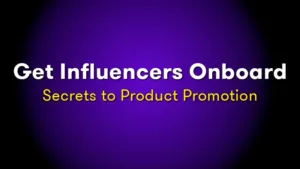How To Get Influencers To Promote Your Products: Our Biggest Secrets Revealed
With over 7 years of e-commerce experience, Agne has mastered the balance of creativity and performance. From guiding social media strategies to crafting high-converting ads, she’s all about results.

In 2024, brands are waking up to the power of influencer marketing. Instead of promoting products in-house, they’re getting legions of social media personalities and brand ambassadors to do the hard work for them.
But there’s a problem. You know your products are great. But influencers don’t. And, because of this, they aren’t always as eager as you would like to promote them.
Fortunately, this article is here to help. It’s a one-stop guide for getting influencers to publicize your products and support your message.
Choose The Right Partnership Type
The first step is to choose the right partnership type. Some are conducive to product promotion, but not all.
Sponsored content is the most straightforward route. With this, you pay influencers to share stories about your products and services with their audiences.
The best part of this arrangement is the ability to provide guidelines and content briefs to creators. These tell them what to do, allowing you to align their message with your branding.
The downside is the authenticity. Paying for positive content can come across as insincere.
Another option is product unboxing videos. Here, you send the product to the influencer and ask them to open it and provide a review.
This approach has more credibility but you don’t have as much control because the influencer can say whatever they want.
Other options for promoting products could include:
- Contests
- Free giveaways
- Social media account takeovers (where you commandeer the influencer’s account for a day)
- Creating brand ambassador relationships (offering consistent messaging to an influencer’s audience)
Sleuth To Find The Right Influencers
Once you settle on a suitable partnership arrangement, the next step is to vet your candidate influencers.
Start by looking for social media influencers in your niche. Cristiano Ronaldo might have 635 million followers on Instagram, but he probably isn’t the man you want representing your company if you sell dog biscuits!
Fortunately, you don’t have to trawl social media sites manually looking for individuals that align with your brand. The boffins have come up with plenty of software-based solutions.
BuzzSumo is one option, letting you find influencers with keywords just as you would using a conventional search engine. Simply type your niche’s keywords into the search bar and voila.
You could also try NinjaOutreach. It specializes in finding relevant social media personalities on YouTube and Instagram.
Billo is another option. We have countless clients who’ve succeeded using our influencer sourcing services.
When you discover an influencer you like, check they align with your values. You don’t want social media personalities contradicting their previous content to sell your product (that’ll look super awkward). For example, don’t choose a pet influencer to promote dog biscuits if they have twenty videos about how much they hate them.
Lastly, consider the influencer’s engagement and audience metrics. Are they acceptable for the money they want you to pay? Ideally, the influencers you choose should have engagement rates between 1 and 5%, with micro- and nano-influencers occupying the higher end of the range.
Lay The Groundwork For A Future Relationship
Next, lay the groundwork and get the influencer more used to you. Building rapport and a relationship ahead of time can make them more likely to work with you when you finally decide to pitch.
It can take time to build a relationship with social media influencers (if they don’t know your brand). So, you’ll want to stick to the basics, such as:
- Following them on their social media accounts
- Sharing their content with other people
- Commenting on their blog posts and Instagram Reels
- Asking them interesting questions that could double as content
- Taking part in their live streams and online discussions
Research Compensation
It also pays to research average influencer compensation for the work you want them to do. Prices usually go up with follower count, engagement rates, and the type of content you want them to produce.
Nano-influencers with less than 10,000 followers are the least expensive. But they often have the highest engagement rates.
Craft the Perfect Pitch
Once you finish sleuthing and laying the groundwork, it is time to craft a compelling pitch. But what should you include in it?
1. Start with personalization
Avoid sending generic, spam messages to influencers. Instead, research them first and find out what makes them tick.
Always address them by their name and try to mention something that makes the message feel more personal (that an email generator couldn’t cook up).
2. Introduce your brand
Next, move on to discussing your brand. Talk about your unique selling point and why it aligns with the influencer and their audience. Ensure the messaging links to your niche and explains why the partnership will work.
3. Talk about mutual benefits
Let the influencer know what’s in it for all parties. This approach builds trust because they can see where you are coming from and what they can expect from working with you.
4. Offer value
Lastly, provide them with some sort of value proposition, including:
- Free products that they can share with their audience
- An upfront payment straight into their bank account
- Membership in your affiliate program
- Special offers, including non-financial perks, like behind-the-scenes access
Set Clear Deliverable For Smooth Sailing
If they agree to work with you, the next step is to set out what you want in more detail.
Start by outlining the types of collaborations you want. These could include sponsored posts, giveaways, and unboxing videos.
You should also provide additional details to ensure everything goes to plan and the partnership generates value for you. For example, you could mention:
- The number of product samples you will send them
- The frequency you want the influencer to post about your products
- The amount of money you are willing to pay
- Whether you will provide shout-outs for them on social media to grow their channel
- The cross-promotions you’ll conduct
- Any ethical or aesthetic requirements (such as avoiding cursing while discussing products)
- Requirements for pre-approval before the influencer releases content
- When promotions will occur (on a schedule or timeline)
Most brands work with a lawyer to write their influencer agreement formalities (at least the first time). After that, they use the same template to protect themselves.
Once that’s done, the relationship is ready to take off. The sky’s the limit.
Creative Manager
With over 7 years of e-commerce experience, Agne has mastered the balance of creativity and performance. From guiding social media strategies to crafting high-converting ads, she’s all about results.

Authentic creator videos, powered by real performance data
22,000+ brands use Billo to turn UGC into high-ROAS video ads.
How to Find Micro Influencers for Your Brand’s...
Looking for micro influencers for your brand’s next campaign? You’re [...]...
Read full articleBeyond the Ad: Influencer Marketing Services for...
Sponsored posts alone won’t cut it in 2025. Global influencer-marketing [...]...
Read full articleTop 20 TikTok Influencers for 2025
Having rapidly evolved from a short-form video app predominantly used [...]...
Read full article




